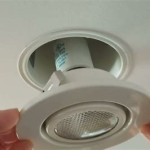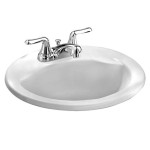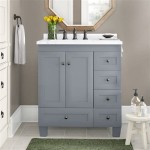Best Cabinets For a Bathroom: A Comprehensive Guide
Choosing the right cabinets for a bathroom is a crucial step in any renovation or new construction project. Bathroom cabinets provide storage, contribute significantly to the overall aesthetic, and must withstand the humid environment inherent in bathrooms. Selecting cabinets that are stylish, functional, and durable requires careful consideration of various factors, including size, material, style, and storage needs. This article will provide a comprehensive overview of the best cabinet options for bathrooms, guiding readers through the key considerations necessary to make an informed decision.
Understanding Bathroom Cabinet Types
Bathroom cabinets broadly fall into several categories, each offering unique advantages. The primary types include vanity cabinets, wall-mounted cabinets, linen cabinets, and over-the-toilet cabinets. Each cabinet type serves a specific purpose and contributes to the overall functionality and organization of the bathroom space.
Vanity Cabinets: Vanity cabinets are the most common type of bathroom cabinet. They are designed to house the sink and provide storage space underneath. Vanity cabinets can be freestanding or wall-mounted. Freestanding vanities rest on the floor and are generally easier to install. Wall-mounted vanities, also known as floating vanities, create a more open and modern look and allow for easier cleaning underneath. Vanity cabinets come in a wide range of sizes, styles, and materials to accommodate different bathroom sizes and aesthetic preferences.
Wall-Mounted Cabinets: Wall-mounted cabinets, also called medicine cabinets when placed above a sink, are hung on the wall and provide additional storage without taking up floor space. These cabinets are ideal for storing toiletries, medications, and other small items. Wall-mounted cabinets can be mirrored or non-mirrored, and they come in various styles to complement the overall bathroom design. Their elevated position helps keep items within easy reach and can contribute to a more organized and less cluttered bathroom.
Linen Cabinets: Linen cabinets are taller and narrower cabinets designed for storing towels, linens, and other bathroom essentials. They can be freestanding or built-in. Linen cabinets provide ample storage space and help keep the bathroom tidy and organized. They are available in various styles and finishes to match the other cabinets in the bathroom and can be instrumental in maximizing storage capacity, especially in smaller bathrooms.
Over-the-Toilet Cabinets: Over-the-toilet cabinets utilize the often-overlooked space above the toilet to provide practical storage. These cabinets typically have shelves or enclosed compartments for storing toiletries, toilet paper, and other necessities. They are a space-saving solution for smaller bathrooms where floor space is limited. Over-the-toilet cabinets are available in a variety of styles and finishes to coordinate with the overall bathroom design.
Key Material Considerations for Bathroom Cabinets
The material used to construct bathroom cabinets significantly impacts their durability, appearance, and resistance to moisture. The most common materials include solid wood, wood veneer, MDF (Medium-Density Fiberboard), and plywood. Each material has its own set of advantages and disadvantages that should be carefully considered when selecting bathroom cabinets.
Solid Wood: Solid wood is a popular choice for bathroom cabinets due to its natural beauty and durability. Common wood species used for bathroom cabinets include maple, oak, cherry, and birch. Solid wood cabinets are known for their strength and resistance to warping and cracking. However, solid wood is more expensive than other materials and can be susceptible to moisture damage if not properly sealed and maintained. The natural variations in wood grain and color add character to the cabinets, making each piece unique. Proper sealing and regular maintenance are essential to protect solid wood cabinets from the humid bathroom environment.
Wood Veneer: Wood veneer consists of a thin layer of real wood applied over a core material, such as MDF or plywood. Wood veneer offers the aesthetic appeal of solid wood at a lower cost. It is also less susceptible to warping and cracking than solid wood. However, wood veneer is more vulnerable to damage than solid wood and can peel or chip if exposed to excessive moisture. The core material underneath the veneer provides stability and strength, while the veneer itself provides the desired wood grain and finish. Careful selection of the veneer and the underlying core material is crucial for ensuring the durability and longevity of wood veneer cabinets.
MDF (Medium-Density Fiberboard): MDF is an engineered wood product made from wood fibers, resin, and wax. MDF is a cost-effective alternative to solid wood and wood veneer. It is more resistant to warping and cracking than solid wood and provides a smooth, uniform surface for painting or laminating. However, MDF is more susceptible to water damage than solid wood and should be properly sealed and protected from moisture. MDF cabinets are a popular choice for painted cabinets due to their smooth surface and ability to hold paint well.
Plywood: Plywood is an engineered wood product made from multiple layers of wood veneer glued together. Plywood is stronger and more resistant to warping and cracking than solid wood and MDF. It is also more resistant to moisture damage than MDF. Plywood cabinets are a durable and reliable option for bathrooms, especially in high-humidity environments. The layered construction of plywood provides strength and stability, making it a good choice for cabinet boxes and shelving.
Selecting the Right Style and Finish
The style and finish of bathroom cabinets play a significant role in the overall aesthetic of the bathroom. There are many different styles and finishes to choose from, ranging from traditional to modern. The choice of style and finish should complement the other elements in the bathroom, such as the flooring, countertops, and fixtures.
Traditional Styles: Traditional bathroom cabinets are characterized by their intricate details, raised panel doors, and ornate hardware. Common traditional styles include Shaker, raised panel, and antique. These styles often feature rich wood finishes, such as cherry, mahogany, or oak. Traditional cabinets evoke a sense of elegance and sophistication, creating a warm and inviting atmosphere in the bathroom. The detailed craftsmanship and classic designs of traditional cabinets make them a timeless choice for many homeowners.
Modern Styles: Modern bathroom cabinets are characterized by their clean lines, minimalist designs, and sleek hardware. Common modern styles include slab door, flat panel, and contemporary. These styles often feature painted finishes, such as white, gray, or black. Modern cabinets create a clean and contemporary look, providing a sense of spaciousness and functionality in the bathroom. The simplicity and understated elegance of modern cabinets make them a popular choice for those seeking a minimalist aesthetic.
Transitional Styles: Transitional bathroom cabinets blend elements of both traditional and modern styles. They often feature simple door designs with subtle details and a mix of painted and wood finishes. Transitional cabinets offer a versatile and adaptable style that can complement a wide range of bathroom designs. The balance between classic and contemporary elements makes transitional cabinets a popular choice for those seeking a timeless yet modern aesthetic.
Finishes: The finish of bathroom cabinets can significantly impact their appearance and durability. Common finishes include painted, stained, and glazed. Painted finishes offer a wide range of color options and can be easily updated to match changing trends. Stained finishes highlight the natural beauty of the wood grain and provide a warm and inviting look. Glazed finishes add depth and dimension to the cabinets, creating a unique and custom look. The choice of finish should consider the overall style of the bathroom and the desired level of maintenance.
Considering Storage Needs and Layout
Before selecting bathroom cabinets, it is essential to assess storage needs and consider the layout of the bathroom. The amount of available space, the types of items that need to be stored, and the desired functionality of the bathroom should all be taken into account. Careful planning can ensure that the chosen cabinets provide adequate storage and contribute to an organized and efficient bathroom space.
Assess Storage Needs: Begin by evaluating the types and quantities of items that need to be stored in the bathroom. This may include toiletries, towels, cleaning supplies, and personal care items. Consider the frequency with which these items are used and the desired level of accessibility. This assessment will help determine the types and sizes of cabinets needed to accommodate these storage requirements.
Maximize Vertical Space: In smaller bathrooms, maximizing vertical space is crucial. Tall linen cabinets, over-the-toilet cabinets, and wall-mounted cabinets can provide ample storage without taking up valuable floor space. Consider installing shelving or drawers within the cabinets to further optimize storage capacity. Vertical storage solutions help keep the bathroom organized and clutter-free, making the most of limited space.
Customize Cabinet Interiors: Consider customizing the interiors of the bathroom cabinets to better suit specific storage needs. Options include adjustable shelves, pull-out drawers, and organizers for toiletries and small items. These customizations can enhance the functionality of the cabinets and make it easier to find and access items. Customized cabinet interiors can also help prevent clutter and maximize the efficiency of the storage space.
Consider the Layout: The layout of the bathroom should influence the placement and types of cabinets chosen. Consider the location of the sink, toilet, and shower or bathtub when planning the cabinet layout. Ensure that the cabinets are positioned in a way that maximizes accessibility and functionality. Avoid placing cabinets in areas where they might obstruct movement or interfere with other fixtures. A well-planned layout can enhance the flow and efficiency of the bathroom space.
By carefully considering these factors, homeowners can select the best cabinets for their bathroom, creating a stylish, functional, and durable space that meets their specific needs and preferences. The investment in quality bathroom cabinets is an investment in the overall comfort and enjoyment of the home.

Guide To Selecting Bathroom Cabinets

Guide To Selecting Bathroom Cabinets

Bathroom Cabinets 7 Of The Best Good Homes Goodhomes

What S The Best Material For Bathroom Vanity Cabinets Allikristé

Bathroom Cabinets Vanities And Remodeling Best Ideas

6 Modern Bathroom Vanity Design Ideas Lily Ann Cabinets

Wall Mounted Bathroom Cabinet Ideas Designcafe
:max_bytes(150000):strip_icc()/grey-08207753dd3b407caadbbb47253586a3.jpg?strip=all)
30 Bathroom Cabinet Color Ideas From Basic To Bold

A Step By Guide To Designing Your Bathroom Vanity

Bathroom Cabinet Design Ideas That Are Functional Stylish For Your Modern Beautiful Homes
Related Posts







